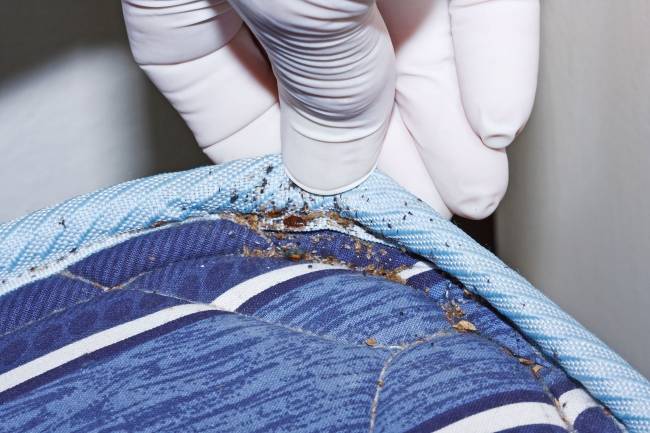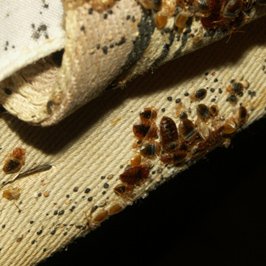Bed bugs are some of the most familiar pests out there. They are up there with cockroaches, rats, and termites. But still, many people seem to lack basic knowledge about these horrible pests. So, here are nine answers to the biggest bed bug questions.
1. What are bed bugs?
Bed bugs are insects that feed on human blood. They are reddish-brown, and their color is even more prominent when they have just fed on blood.
Bed bugs are small creatures, clocking in at just about one to seven millimeters in length. Despite their size, they are still very visible under ideal light conditions. However, they are nocturnal insects, and it may be harder to spot them at night because of the lower lighting.
2. Do bed bugs bite?
One of the most common bed bug questions out there is, do bed bugs bite? Yes, they do. Biting is their primary way of getting through your skin and feeding on your blood. Bed bug bites can be incredibly itchy because when bed bug saliva goes into your body, it triggers your immune system and leads to an allergic reaction.
Bed bugs themselves are not known to spread diseases. But the itching from bed bug bites can lead to irritations, wounds, and worst of all, infections.
3. How do you get bed bugs?
There are so many ways to get bed bugs in your home. You can get them from college dorms, offices, laundromats, hospitals, and even hotels that are supposed to be the bastions of cleanliness. Bed bugs are incredible hitchhikers, so they can easily get into your belongings like your luggage. And then start an infestation in your home once you unlock your belongings.
You can also get bed bugs from secondhand furniture. It’s good practice to always check secondhand furniture before buying it. You don’t want to mindlessly bring it home to introduce bed bugs on your property. Also, take note that bed bugs thrive not just in bed frames and mattresses, so you definitely want to check those secondhand sofas and tables as well.
4. How do you know if you have bed bugs?
Look for the signs of a bed bug infestation. The strongest sign is seeing live bed bugs. But this can be a tricky sign to look for because of their size and the time of day they are active. Look for the other signs instead.
You will see bed bug carcasses near bed bug hiding spots. You may also see black or brown smear marks, which can be bed bug fecal matter. If the infested area is a mattress, sofa, or anywhere else where they can bite someone, you may also see red smear marks, which are actually bloodstains.

5. Where do bed bugs hide?
This is one of the strongest bed bug questions out there. It is important to know where bed bugs hide, so you know where to concentrate your bed bug control methods. It is easy to assume that the bedroom is their favorite spot. After all, they want to be as close to their blood source as possible. This is true to some extent, but take note that they can hide anywhere near where a blood source sleeps or rests.
Their most basic hiding spots are bed frames, mattresses, and all their cracks and crevices. But they can also hide in carpets, walls, bedside tables, and wardrobes, especially those that are near sleeping or resting areas.
6. How do you get rid of bed bugs?
Bed bugs are vulnerable to extreme temperatures. For this reason, heat is one of the primary tools pest control professionals use to get rid of bed bugs. But here’s the thing — bed bugs are really good at hiding. Even though you know their weakness, you won’t be able to exploit it to get rid of the infestation.
Bed bugs are complicated pests. There may be effective DIY bed bug control methods out there. But because of the complications associated with bed bug infestations, it’s best to let pest control professionals handle them.
7. How do you prepare for bed bug treatment?
Yes, pest control professionals should be the ones handling bed bug treatments. But this doesn’t mean you don’t have to do anything. You get to play a part as well to ensure the effectiveness of the treatment. This is where bed bug treatment preparation comes in.
Avoid moving items from room to room. Since bed bugs are incredible hitchhikers, the items you move may introduce bed bugs to rooms that are not originally infested. You want the infestation to be as concentrated as possible.
Also, inspect items around your home if they have bed bugs. If they do, leave them, so they get exposed to the bed bug treatment. If you are sure they don’t, double wrap them, so they don’t get contaminated.

8. How long does it take to get rid of bed bugs?
This is one of the bed bug questions of the truly concerned homeowner. And there’s a good reason for it. Even after undergoing a bed bug treatment session, homeowners may still see bed bugs around their property. This is actually okay because a complete bed bug treatment requires multiple sessions.
Typically, an entire treatment will last three to six weeks with about two to four sessions. But these numbers are flexible. There are many factors that determine how long it will take to get rid of bed bugs, such as the severity of the infestation, the reach of the treatment, and the bodily resistance of the bed bugs.
9. How do you prevent bed bugs from coming back?
The best way to prevent bed bugs is to avoid hitchhikers. Whenever you are in an area that potentially has bed bugs, like college dorms and hotels, inspect your room first before settling in. It also helps to have sturdy bags with your clothes wrapped in plastic inside. This will prevent bed bugs from getting into your luggage when you are traveling.
Look for the signs of bed bug infestations when you are buying secondhand furniture. If you can, buy only from legitimate stores with sanitation protocols to minimize the risk of getting a piece infested with bed bugs.

